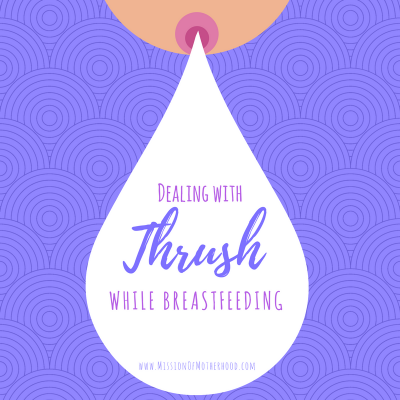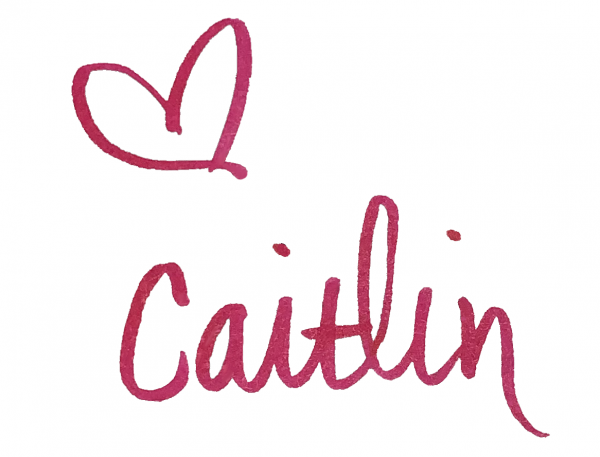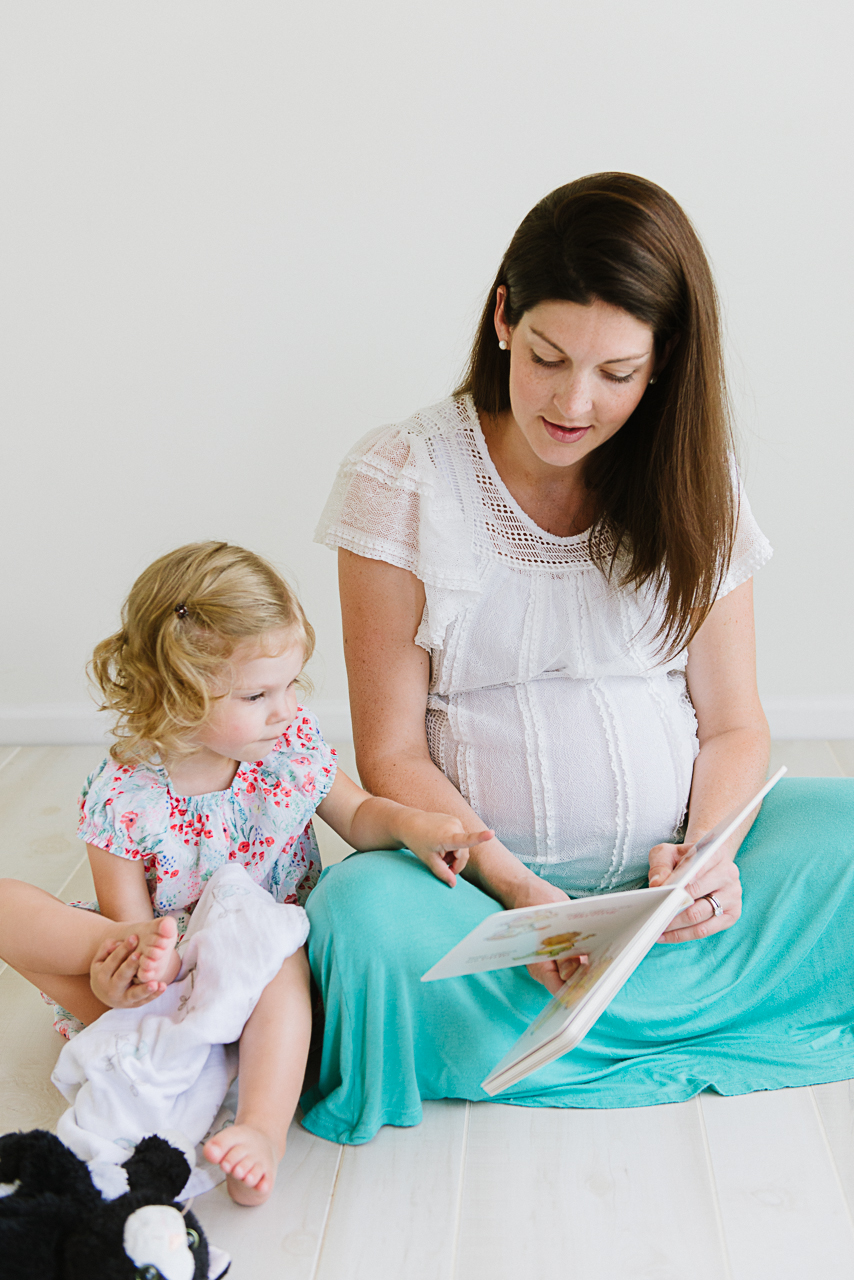This post contains affiliate links. View my Disclosures page for more information.
Thrush! Ah, that pesky devil. Thrush is also known as a yeast overgrowth on the nipples, or the baby’s mouth, in the ducts, or all of the above. This annoying breastfeeding problem can be uncomfortable but is easily solved. Read on for what worked for me, along with some recommendations I learned from my lactation consultants, breastfeeding support groups, and other nursing mothers.

Disclaimer: I’m a mom, but I’m not your mom. I’m also not a doctor or certified lactation consultant. So, even though I’ve been breastfeeding for, at the time of this post, a consecutive 36 months, I still have to tell you to take this advice with a grain of salt and encourage you to do your own research. Seek medical attention if you need it.
Candida albicans lives on the skin of all humans, but sometimes situations cause an imbalance in the pH leading to what’s commonly called thrush. Some people, for whatever reason, are more prone to yeast overgrowth. Some of the first indicators of thrush can be a painful latch or a very white oral cavity on the baby. It’s not ALWAYS obvious, and pain from poor latch, vasospasms, or Raynaud’s can be confused for yeast.
I distinctly remember feeling a deep scraping pain when my baby first latched. Later when I read up on symptoms of thrush, I thought “deep breast pain? I don’t have that.” In hindsight, I did, but I would’ve described it differently: it felt like she was sucking sandpaper through my milk ducts, starting very far inside, almost like it started at my shoulder blade or on my back. I mistook this for the feeling of letdown, but later realized this was a classic sign of nipple yeast, or thrush.
She did not have the telltale white tongue and cheeks, but the general recommendation is to treat both the mother and the baby once yeast is confirmed, as it’s common in breastfeeding to pass it back and forth. Below are some remedies for thrush and my experiences with them.
THE BASICS
First of all, it’s helpful to know Candida albicans lives on the skin of all humans, as I said before. When the conditions are right, however, it can turn into an overgrowth that we call a yeast infection. It’s usually called thrush when it’s in the baby’s mouth, or nipple yeast when it’s on the mother’s breast.
It can pass back and forth, if the conditions are right. When I say conditions, I mean dark, warm, moist, sweet. You can see why yeast would form in a mouth, a nipple, or in a diaper area. A wound can be a breeding ground as they are often dark, warm, and moist. It’s also VERY common to experience yeast infections after antibiotics, or with the use of inhaled steroids, so keep your medications in mind when you’re trying to determine if you could be dealing with thrush.
Breastmilk pumped or expressed during a thrush overgrowth is perfectly safe to drink. You can’t exactly “catch” yeast, because as I said Candida already lives on our skin. It’s only problematic when the conditions are right. So if baby has thrush in their mouth and you have no symptoms but you do have a cracked nipple, you might be prone to it.
Freezing or refrigerating “thrush milk” won’t kill the yeast but does deactivate it; again, it’s safe to use. If you’re worried, for whatever reason, you can scald your milk after pumping before freezing. However, it’s a lot of work for not a whole lot of return, and I like to keep breastfeeding simple, as it was intended to be.
Many times you need to combine multiple methods for full treatment. For example, a topical anti-fungal is effective, but if you’re not taking care to keep your nipples clean and dry, you may find yourself dealing with it again.
SUNLIGHT
Or any light, can help thwart a yeast over growth. Air drying, sunlight, or light from the window, the room, etc. can help keep the affected area dry and light. I used to walk around with my top off indoors. A lot of my nursing tanktops and bras weren’t super breathable, and I think the stretchy material kept my nipples in the dark. Obviously sunlight in a baby’s mouth is less convenient, but for yourself, hang your bras in the window to catch some light and dry those girls out.
PROBIOTICS & YOGURT
A daily probiotic can help cure and prevent yeast, but it’s more effective as a preventative. They sell jarred, liquid, and powdered varieties on Amazon, at Whole Foods, and many drugstores and grocery stores. I have this one and this one, but literally, there are tons out there. They are helpful for mom and baby.
Yogurt has live probiotic cultures which help fight off yeast overgrowth. Eating yogurt, or another live culture food, daily can help kick yeast or keep infections at bay completely. If you’re dairy free, there are a lot of options out there for non-dairy yogurt with live cultures.
NEWMAN’S APNO
APNO, also known as all-purpose nipple ointment, can help. There is an Rx version, often expensive but many times covered by insurance (and has to be filled at a compounding pharmacy). There is also an over-the-counter cheaper version that I found to be just as effective. APNO, both the Rx variety and the OTC version, contains an anti-fungal (usually miconazole nitrate 2%), that topically treats the yeast.
TOPICAL ANTIFUNGALS
Miconazole nitrate 2%, also known as Monistat 7, is in the prescription APNO and is safe to nurse with. A small amount, enough to make the nipple and areola shiny, is sufficient. Do not wipe off before bringing baby to the breast. Let your nipples air dry after nursing. Reapply to both sides after every feeding.
Clotrimazole 1%, also known as Lotrimin AF, is also an effective topical anti-fungal for thrush. Same rules apply as above. They aren’t absorbed systemically, so they’re safe to nurse with. Both are incredibly effective.
NYSTATIN
Sometimes pediatricians/OBs will prescribe an oral Nystatin suspension for thrush. I learned the hard way that this is not a medication to just put in a dropper and try to get the baby to swallow. First off, it’s sticky and gross. Second, it’s a topical anti-fungal for the treatment of an oral yeast infection, and is not absorbed systemically.
If you are given Nystatin for the baby, apply it on the inside of her cheeks, tongue, and roof of mouth. It’s ok if they spit it out. It’s ok to use a dropper, Q-tip, or your finger to apply it. You want it to come into contact with the inside surfaces of the baby’s mouth. It’s not harmful if she swallows it, she’ll just poop it out, but it’s more effective if it is applied as a topical solution.
You can also apply it directly to your nipple/areola, but when I say it’s sticky, hear me loud and clear: it’s sticky.
DIFLUCAN
Fluconazole, aka Diflucan, is a prescription anti-fungal. It is strong and can be given in various doses, and very effective. Its safe to nurse while taking this, but I was glad the second and third times I had thrush that I didn’t need it because I’d found other effective remedies.
I’ll be honest: going to the pharmacy, waiting in line, paying, possibly needing to wait another day or drive farther because of hours, none of that was appealing or convenient as a new mom. I also couldn’t get a prescription for Diflucan without making an appointment to see my doctor, which felt like another hoop to jump through for treatment when I was already struggling. I’m thankful for modern medicine and respect doctors wholeheartedly, but I won’t lie, this was incredibly inconvenient to me. It was much easier for me to get what I needed online or at a grocery store, or better yet, send my husband out, than it was for me to try and coordinate scheduling that whole mess.
Update: I successfully took ketoconazole while breastfeeding with no adverse effects, so that’s another prescription option for pesky yeast.
GENTIAN VIOLET
I had thrush 3 times in 16 months. Gentian violet was definitely one of the most effective remedies. My nursling and I both looked like Barney and I stained a bra in the process. It worked better than 3 days of Motherlove Thrush ointment.
Gentian Violet is a purple liquid that STAINS clothes but is extremely effective as a natural antiseptic and works well for thrush. It washes off skin in a few days.
- Apply to nipples/areolas with a cotton swab or Q-tip til nice dark purple. It can stain grout and counter tops, so be careful where you’re applying it.
- Air dry.
- Coconut oil on baby’s face (lips/outside of cheeks, outside of lips, tip of nose) can help the purple not stain the face so much (it washes off either way in a day or so).
- Nurse baby. You WANT the inside of their mouths to be purple!
- Wear dark or black bras/nursing shirts because I’m not kidding when I say it stains clothes. Baby will look like they made out with Barney for a few days.
- Repeat until symptoms improve, usually 1-2 days.
MOTHERLOVE DIAPER RASH AND THRUSH OINTMENT
This stuff is magically delicious. Amazon must be sold out because of all the glowing reviews I’ve given this stuff (ha, if only). I have also purchased it in store from Whole Foods and other “ecobaby” stores locally. It’s usually around $10-12/jar, and it seems they’ve changed the name, but here is the stuff.
I don’t know that it was super effective for thrush by itself, just because it took 3-4 days to really notice improvements, but it definitely provided symptom relief. And, combined with some other remedies, it could have absolutely helped. If nothing else, it smelled nice, definitely soothed sore nipples (so it gets a huge win in my book just for that alone), and I think it absolutely helped in the prevention of thrush or diaper rash down the road.
It was a lovely lubrication for pumping, too, especially with sore nipples. And it DEFINITELY helped heal my youngest daughter’s stubborn yeast rash when I combined it with an antifungal powder.
OTHER HELPFUL INFORMATION:
From KellyMom:
https://kellymom.com/bf/concerns/child/thrush-resources/
Honestly, this post has more information than you could truly ever need. KellyMom is always one of my first go-to recommendations, and is chock full of good evidence based stuff.
From Dr. Jack Newman:
https://www.breastfeedinginc.ca/informations/using-gentian-violet/
https://www.breastfeedinginc.ca/informations/candida-protocol/
Other:
https://momlovesbest.com/thrush-breastfeeding


